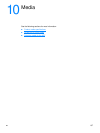
140 10 Media EN
Envelopes
Envelope construction
Envelope construction is critical. Envelope fold lines can vary considerably, not only between
manufacturers, but also within a box from the same manufacturer. Successful printing on
envelopes depends on the quality of the envelopes. When selecting envelopes, consider the
following factors:
● Weight: The weight of the envelope paper should not exceed 105 g/m
2
(28-pound), or
jamming might result.
● Construction: Prior to printing, envelopes should lie flat with less than 6 mm (0.25 inch) curl
and should not contain air. Envelopes that trap air may cause problems.
● Condition: Make sure that the envelopes are not wrinkled, nicked, or otherwise damaged.
● Sizes: From 90 x 160 mm (3.5 x 6.3 inches) to 178 x 254 mm (7 x 10 inches).
Envelopes with double-side seams
An envelope with double-side-seam construction has vertical seams at both ends of the envelope
rather than diagonal seams. This style might be more likely to wrinkle. Make sure that the seam
extends all the way to the corner of the envelope as shown in the following illustration:
Envelopes with adhesive strips or flaps
Envelopes with a peel-off adhesive strip or with more than one flap that folds over to seal must use
adhesives compatible with the heat and pressure in the printer: 200° C (392° F). The extra flaps
and strips might cause wrinkling, creasing, or jams.
Envelope storage
Proper storage of envelopes contributes to good print quality. You should store envelopes flat. If air
is trapped in an envelope, creating an air bubble, the envelope might wrinkle during printing.
Card stock and heavy media
You can print many types of card stock from the paper input tray, including index cards and
postcards. Some card stock performs better than others because its construction is better suited
for feeding through a laser printer.
For optimum printer performance, do not use paper heavier than 157 g/m
2
(42-pound). Paper that
is too heavy might cause misfeeds, stacking problems, paper jams, poor toner fusing, poor print
quality, or excessive mechanical wear.
Acceptable
Unacceptable


















